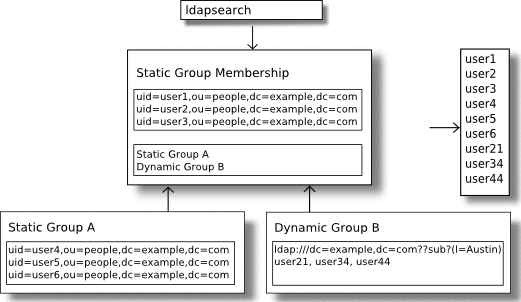| Exit Print View | |
Sun OpenDS Standard Edition 2.0 Administration Guide |

|
Configuring the Directory Server
Configuring Security in the Directory Server
Managing Root User, Global Administrator, and Administrator Accounts
Working With Multiple Root Users
Root Users and the Privilege Subsystem
Managing Root Users With dsconfig
To View the Default Root User Privileges
To Edit the Default Root User Privileges
To Change a Root User's Password
To Change a Root User's Privileges
Setting Root User Resource Limits
Managing Global Administrators
Password Policies in a Replicated Environment
To View the List of Password Policies
Properties of the Default Password Policy
To View the Properties of the Default Password Policy
To Create a New Password Policy
To Create a First Login Password Policy
To Assign a Password Policy to an Individual Account
To Prevent Password Policy Modifications
To Assign a Password Policy to a Group of Users
To Change the Directory Manager's Password
To Reset and Generate a New Password for a User
Managing a User's Account Information
To View a User's Account Information
To View Account Status Information
Setting Resource Limits on a User Account
To Set Resource Limits on an Account
To Create a Static Group With groupOfNames
To Create a Static Group With groupOfUniqueNames
To Create a Static Group With groupOfEntries
To List All Members of a Static Group
To List All Static Groups of Which a User Is a Member
To Determine Whether a User is a Member of a Group
To List All Members of a Dynamic Group
To List All Dynamic Groups of Which a User Is a Member
To Determine Whether a User Is a Member of a Dynamic Group
Defining Virtual Static Groups
To Create a Virtual Static Group
To List All Members of a Virtual Static Group
To List All Virtual-Static Groups of Which a User Is a Member
To Determine Whether a User is a Member of a Virtual Static Group
Maintaining Referential Integrity
Overview of the Referential Integrity Plug-In
To Enable the Referential Integrity Plug-In
Simulating DSEE Roles in an OpenDS Directory Server
To Determine Whether a User is a Member of a Role
Groups can be nested, where one group is defined as a child group entry whose DN is listed within another group, its parent. The nesting of groups allows you to set up inherited group memberships when performance is not a priority. You can add zero or more member attributes with their values set to the DNs of nested child groups, including both static and dynamic groups.

This example procedure creates a nested group using one static group and one dynamic group.
This example file, static-group.ldif, specifies a virtual static group named Dev Contractors.
dn: cn=Contractors,ou=Groups,dc=example,dc=com cn: Dev Contractors objectclass: top objectclass: groupOfUniqueNames ou: Dev Contractors Static Group uniquemember: uid=wsmith,ou=Contractors,dc=example,dc=com uniquemember: uid=jstearn,ou=Contractors,dc=example,dc=com uniquemember: uid=pbrook,ou=Contractors,dc=example,dc=com uniquemember: uid=njohnson,ou=Contractors,dc=example,dc=com uniquemember: uid=sjones,ou=Contractors,dc=example,dc=com
$ ldapmodify -h localhost -p 1389 -D "cn=Directory Manager" -w password \ --defaultAdd --filename static-group.ldif
This example file, dynamic-group.ldif, specifies a dynamic group named Developers.
dn: cn=Developers,ou=Groups,dc=example,dc=com cn: Developers objectclass: top objectclass: groupOfURLs ou: Groups memberURL: ldap:///ou=People,dc=example,dc=com??sub?(ou=Product Development)
$ ldapmodify -h localhost -p 1389 -D "cn=Directory Manager" -w password \ --defaultAdd --filename dynamic-group.ldif
This example file, nested-group.ldif, specifies a nested group named Developers Group.
dn: cn=DevelopersGroup,ou=Groups,dc=example,dc=com cn: Developers Group objectclass: top objectclass: groupOfUniqueNames ou: Nested Static Group uniquemember: cn=Contractors,ou=Groups,dc=example,dc=com uniquemember: cn=Developers,ou=Groups,dc=example,dc=com
$ ldapmodify -h localhost -p 1389 -D "cn=Directory Manager" -w password \ --defaultAdd --filename nested-group.ldif